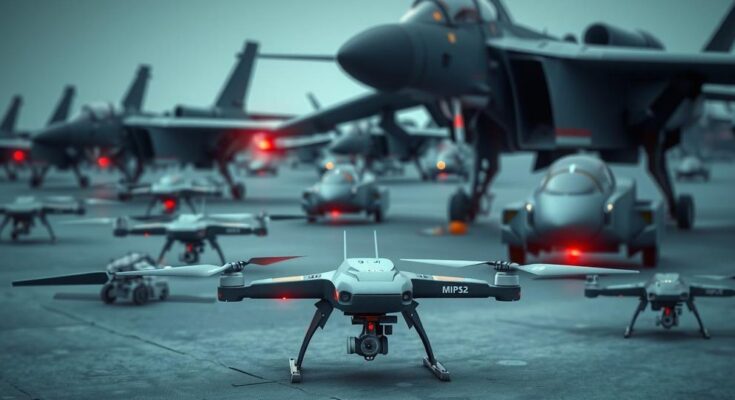Kamikaze drones are transforming warfare by offering a cost-effective solution against sophisticated military assets, with a significant focus on their role in contemporary conflicts. India is advancing its drone capabilities, developing indigenous solutions that streamline production costs while enhancing combat efficacy. The integration of swarm technology and AI indicates a forward-looking approach to drone warfare, asserting India’s strategic position amid geopolitical challenges.
Kamikaze drones are significantly changing the dynamics of modern warfare, emphasizing cost-effectiveness against more expensive military equipment. For instance, Russia’s Lancet-3 and Ukraine’s Switchblade drones have highlighted the efficacy of loitering munitions on the battlefield. Similarly, Israel’s Harop drones and Iran’s Shahed-136 have proven that inexpensive drones can challenge even advanced defense systems, effectively demonstrating their crucial role in contemporary conflicts.
Lt. Gen. Dhiraj Seth shared insights at a recent seminar, asserting that low-cost drones are becoming essential force multipliers in today’s conflicts. He pointed to the devastating impact of these drones, noting a cost ratio of 20,000:1, where a $500 drone can destroy a $10 million tank. This stark reality underscores the pressing need for strong counter-drone measures, including electronic warfare capabilities and advanced interceptors.
In response, India is actively developing its drone capabilities, focusing on indigenous production of loitering munitions and autonomous drones. The operational SkyStriker drone boasts a 500 km range, while the newly introduced Nagastra-1 is tailored for high-altitude skirmishes along the India-China border. Additionally, Indian firms, such as ZMotion Autonomous Systems and Tata Advanced Systems, are innovating cheaper alternatives to imported drones.
As drone warfare evolves, swarm technology is becoming increasingly relevant. India has demonstrated capacities with coordinated drone swarms, indicating a shift towards collective drone operations on the battlefield. Research on AI-driven drones capable of intelligence gathering is in progress, promising enhanced detection of enemy positions.
Despite advancements, cost efficiency remains a challenge as Indian drones, although less expensive than Israeli options, are pricier than Russian and Iranian drones. Continuous innovation is essential for domestic manufacturers to compete effectively in the global market. Western entities are also making strides in loitering munitions, indicating increasing competition.
India’s strategic focus on developing affordable and effective drone technology is vital for maintaining security amidst rising regional tensions. By leveraging indigenous capabilities and advancing in swarm technology and AI integration, India aims not only to enhance its military readiness but also to redefine future warfare strategies. The urgency for superior counter-drone systems and the need for greater self-reliance in defense manufacturing are central to realizing these aims.
Original Source: m.economictimes.com




